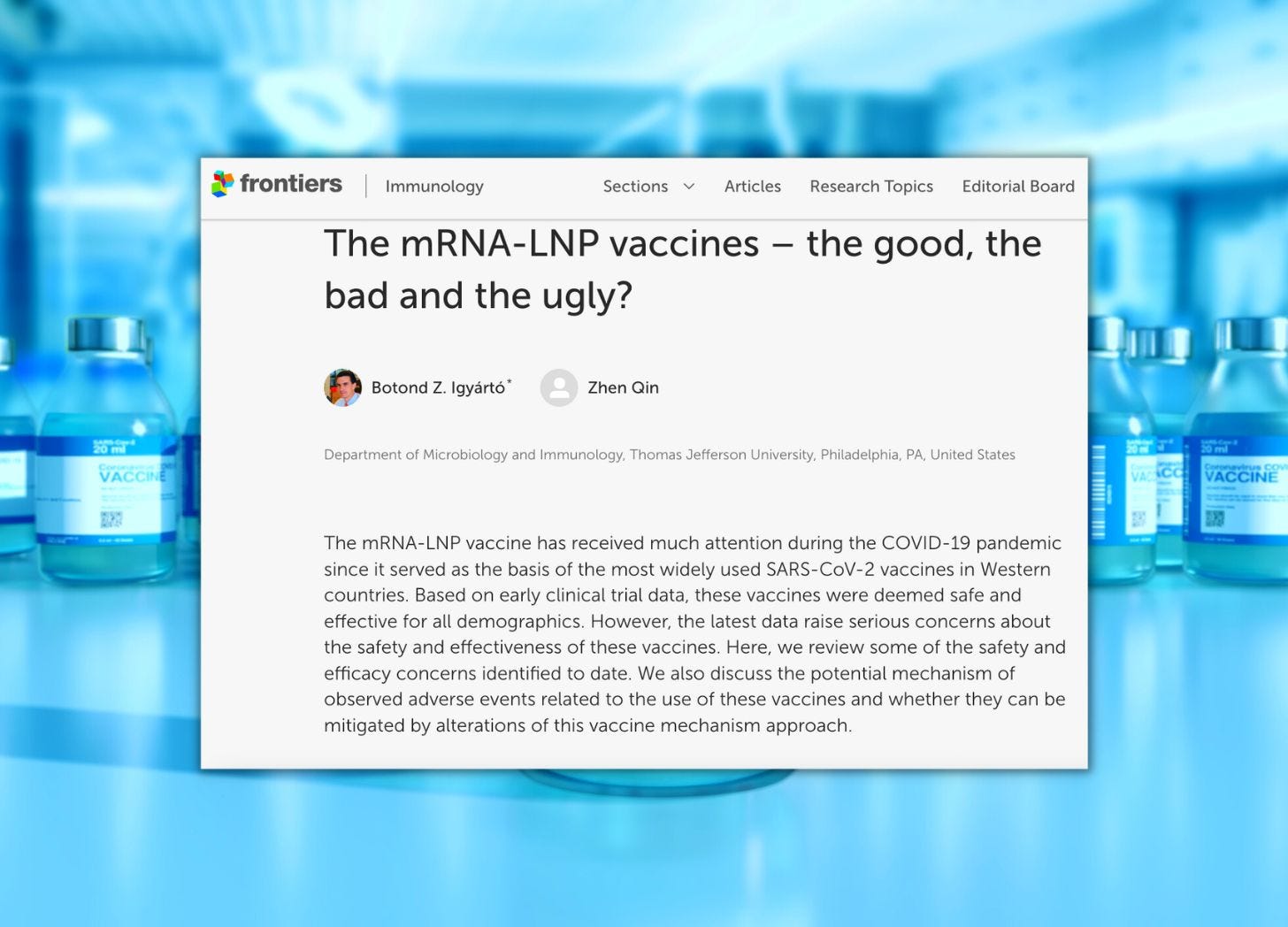'Latest Data Raise Serious Concerns About the Safety and Effectiveness' of COVID Jabs: Journal 'Frontiers in Immunology'
Authors warn about foreign "DNA insertion into the human genome."
A perspective article published this month in Frontiers in Immunology analyzes the safety and effectiveness of mRNA COVID-19 vaccines.
Follow Jon Fleetwood on Instagram @realjonfleetwood / Twitter @JonMFleetwood
The authors, from Thomas Jefferson University’s Department of Microbiology and Immunology, point out the new mRNA vaccine platform poses “novel, untested, and previously unregulated aspects of impurities during manufacture.”
They also emphasize how levels of DNA contamination in both Moderna and Pfizer mRNA jabs have “exceeded the levels set by the European Medicines Agency (EMA) and The United States Food and Drug Administration (FDA).”
“Low levels of double-stranded RNAs (dsRNA) that can form during the production process and can activate innate immune sensors and induce inflammation, have also been reported for both Pfizer and Moderna mRNA vaccines,” they write.
The authors warn that the introduction of new DNA into the human genome, particularly within reproductive stem cells, poses a significant concern:
“New DNA insertion into the human genome would be a serious concern if it happens on the level of stem cells of the reproductive system,” they continue, underscoring the “danger when we assume and extrapolate in science and apply existing paradigms to new, untested platforms.”
Experiments show that the Pfizer lipid nanoparticle (LNP) vaccine’s mRNA can turn into DNA in human liver cells, with the LNPs helping transport the mRNA into the nucleus, possibly allowing SARS-CoV-2 RNA to integrate into the genome.
“With the Pfizer mRNA-LNP vaccine, it has been shown experimentally that the vaccine mRNA can be reverse-transcribed into DNA in an immortalized human hepatocyte cell line,” the perspective article reads.
“The NLS allowed the transport of the spike protein to the nucleus, and it seems that the spike protein also shuttled the spike mRNA to the nucleus. A study also showed that SARS-CoV-2 RNA can be reverse-transcribed and integrated into the genome of cultured human cells, a process potentially mediated by LINE-1 elements, and can be expressed in patient-derived tissues.”
Follow Jon Fleetwood on Instagram @realjonfleetwood / Twitter @JonMFleetwood
Also, the mRNA-LNP spreads throughout the body, accumulating in the testes and ovaries, and has been linked to changes in women’s menstrual cycles, suggesting it might reach reproductive organ stem cells.
“Because the mRNA can enter the nucleus, where it might be reverse-transcribed into DNA, this increases its potential to integrate into the genome. Furthermore, the mRNA-LNP diffuses throughout the body and can accumulate in both the testes and ovaries and is reported to alter the menstrual cycle in women. Therefore, it could potentially be reaching the stem cells of the reproductive organs.”
The authors pose the question: “How safe and effective are the mRNA-LNP vaccines?”
Their answer is that while the shots were deemed safe and effective at first, “recent peer-reviewed research studies, a wide variety of continuously increasing case reports, and publicly available adverse events databases cast doubts on the safety and effectiveness of these products.”
Clinical trials have “revealed excess risk of severe adverse events (SAEs) of special interest with both the Pfizer and Moderna COVID-19 vaccines.”
“Combined, there was a 16% higher risk of SAEs in mRNA vaccine recipients,” the Frontiers article adds.
Some of these SAEs include severe inflammatory/autoimmune events of bone marrow, liver, skin, cardiovascular-, musculoskeletal-, endocrine-, and nervous systems.
These “sometimes [have] been fatal” and have even been “steadily increasing.”
The incidence of adverse events is “far higher” for the mRNA-LNP-based COVID vaccines, the article authors confirm.
And since deaths and SAEs often occur soon after injection, they are “more likely to be the consequence of the vaccine and not just a random event.”
SAEs from mRNA-LNP vaccines are “likely caused by the combination of the mRNA-LNP vaccine components and potentially by direct toxicity and biological action of the spike protein itself.”
The perspective article goes on to call into question the COVID jab’s effectiveness.
Regarding the ability of mRNA jabs to prevent infections and limit the spread of the virus, the authors argue the drug’s “efficacy is mainly limited to potentially decreasing the disease severity and death in susceptible people.”
At the end of their perspective piece, the authors reason that the unprecedented mass vaccination campaigns, “with a vaccine that minimally protects from getting infected and spreading the virus during a pandemic,” raises the following questions:
“Was it a sound strategy?”
“Was herd immunity a realistic expectation?”
“Did this strategy inadvertently accelerate virus mutations, and could a more targeted focus on vulnerable populations have yielded better results?”
You can read the full perspective article below:
Follow Jon Fleetwood on Instagram @realjonfleetwood / Twitter @JonMFleetwood


